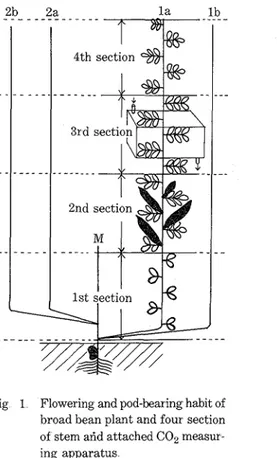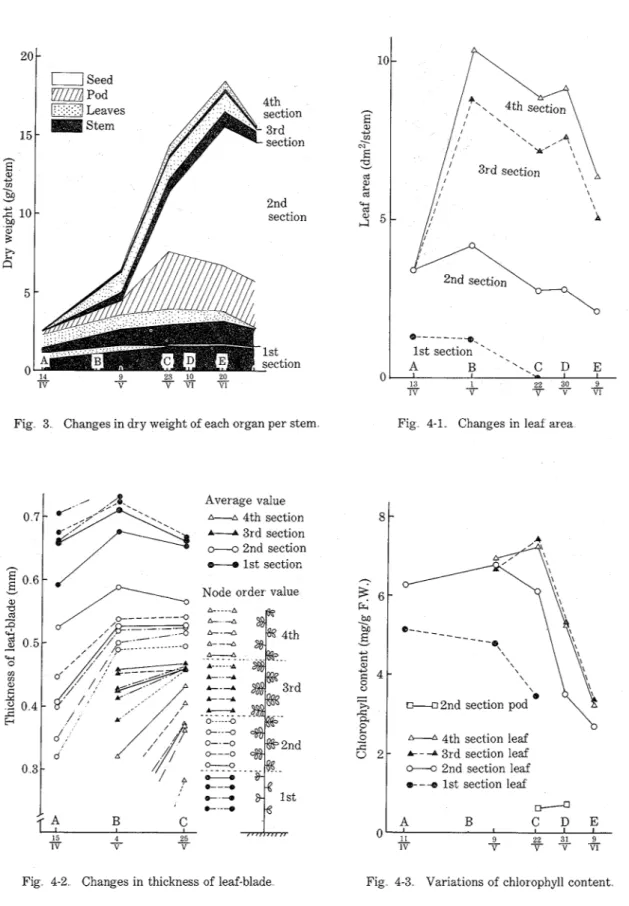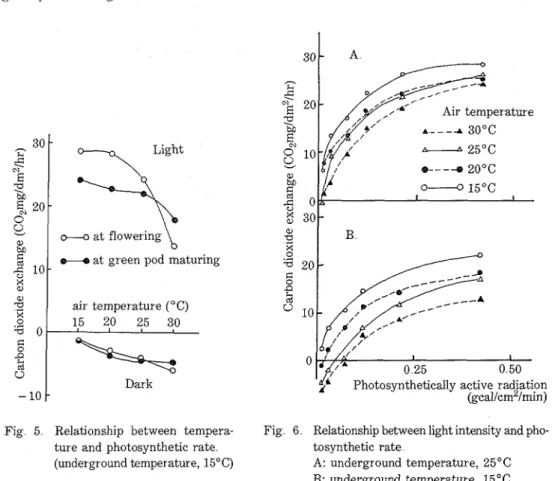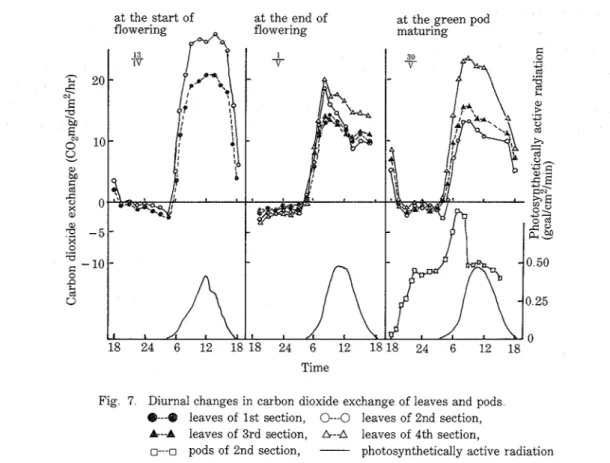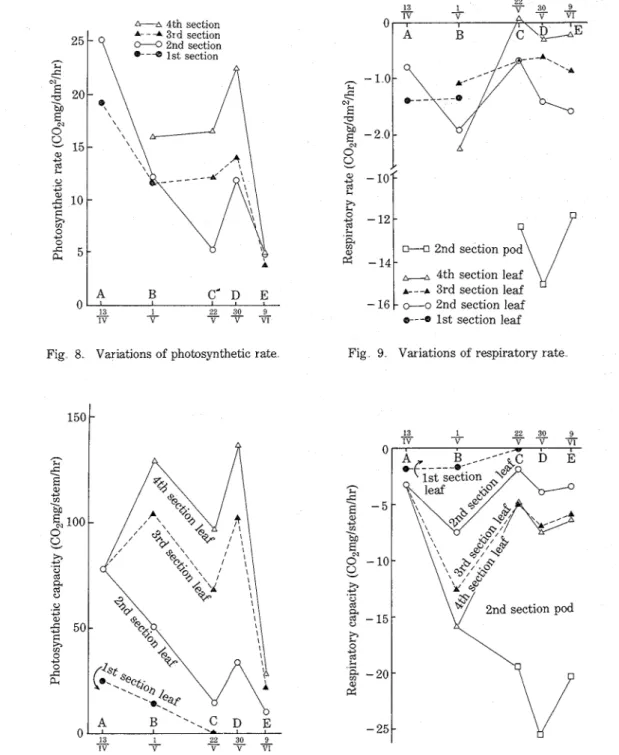Tech Bull Fac Agr Kagawa Univ , Vol 37, No 2, 85-96, 1986
PHYSIOLOGICAL STUDIES OF THE GROWING PROCESS
O F BROAD BEAN PLANTS
IX
On the characteristics and the variations of carbon dioxide
exchange of leaves and pods
Kiyoshi KOGURE,
Shinjiro YOSHIHARA,
Hironobu WADA
and Junzaburo NAKA
The present investigation was undertaken to obtain some informations concerning the relation between the vari- ations of carbon dioxide exchange of leaves and pods in four sections based on the flowering and pod-bearing habit and its meanings for the production and distribution of dry matter of broad bean plant
The photosynthesis of leaves was adaptable in the wide range of 15 to 30°C, especially high in the later growing penod In this range of temperature, the hght compensation and saturation point were 0 01 and 0 20 to 0 30 g cal, cm-', min-I of photosynthetically active radiation The maximum photosynthetic rate was recognized about 20 C 0 2 mg, dm-', hr-', and the photosynthesis of leaves showed a mid-day depression
Although the photosynthesis of leaves seemed to retain for a considerable long time after reaching high value, it behaved closely with the physiological age of leaves and with the presense of pods or not The photosynthetic capacity was high a t the flowering and the early stage of seed maturing The respiration of leaves in the night time was generally low with the except~on in the 2nd section of pods bearing The respiratory capacity was relatively high in the 2nd and 3rd section
The respiration of pod was vigorous throughout the all day and development The diurnal course of the respirato- ry rate was unique; the high value of the night time declined with sunrise, which was found as the fastest but short- est phenomenon Accordingly, though the green pod has somewhat photosynthetic activity, the high respiration, substantiating the translocation and distribution of the photosynthate, seems to overcome
Judging from the results it may be pointed out that the shortage of the substances by the photosynthesis is an important factor for the growth and seed yield, and that the role of leaves in the 1st section participates to the following developing organs and that of middle 2nd and 3rd and upper 4th section moves up stepwise participating for the pod and seed development, especially that of 2nd section is the most important
86 Tech Bull Fac Agr Kagawa Univ
,
Vol 37, No 2 (1986)Introduction
Broad beans produce generally much waste reproductive organs with less mature pods or seeds in contrast with developing huge vegetative organs SO PER(^') has suggested in review that the lack of specific growth substances and the shortage of carbonaceous and mineral substances accounted for this phenomenon Authors have been ex- amined this fact by means of treatments of varing the soil moisture(23), soil fertility(24), light intensity(25), light du- ration(2s), leaf area(26), and plant density(27), and assured the shortage of carbonaceous substances was an impor- tant factor for this phenomenon
Broad beans cultivated in warm region of Japan, generally have four pod-bearing branched stems and in addition have few stems of flowering but pod-shedding The former reproductive stems are developed during the early grow- ing period in winter and have generally 20 to 24 nodes and compound leaves in following the flowering to maturing period of spring And flowers begin to bloom from the seventh or its adjacent node order toward tip of stem Conse- quently, it is clearly that the vegetative growth progresses together with the development of reproductive organs and that the physiological role of vegetative organs changes with the growing process(21,22)
It is well known that plant leaves of different age show differences in their physiological status, i e the dry mat- ter production, photosynthesis, and respiration As for broad beans, a physiological function of leaves and stems of different section based on the flowering and pod bearing habits had been examined by partial leaf
or leaf shadink7) trials Author et a1 (26) pointed out that the role of the vegetative organ transmitted from lower to upper section and the existence of that in the 2nd section were very important for the normal growing process
The object of this investigation was to obtain some informations of the characteristics of carbon dioxide exchange of leaves and pods and its meanings for the production and distribution of dry matter throughout the growing period
Materials and Methods
Broad beans (VICI~ faba), cultivar "Sanuki-nagasaya" were sown in nursery bed on November 8 to 10, and seed- lings were transplanted two plants per pot on December 13 to 18 Each pot received 1 9 g ammonium sulfate, 3 1 g superphosphate, and 1 7 g potassium sulfate Soil moisture was maintained about 70 % of the field capacity
Although the main stem die generally in winter, there have primary four branched stems a t first and second node order of the main axis in the early growing period and these stems grow similarly following three to four months in spring (Fig 1) With regard to the flowering and pod bearing habits of these stems above mentioned, 20 to 24 nodes are possible to be distinguished into the following four sections(26); (1) no flowering, 1st to 6th node order (1st section), (2) first flowering and pod bearing, 7th to 11th node order (2nd section), (3) flowering but generally pod shedding, 12th to 16th node order (3rd section), and (4) no flowering, upward node order (4th section)
In this experiment, out of these primary stems, l a , the first branched one was used, and middle three compound leaves in every sections and pods in the 2nd section were pursued measuring the activity of photosynthesis and respiration The apparatus is shown in Fig 1 ; measurement of carbon dioxide exchange was made by enclosing organs with a acrylic resin chamber, which was connected to an infra-red C02 gas analysis system At the same time the photosynthetically active radiation was measured with the photosynthetically active radiometer
Experiment I ; In order to obtain some informations concerning the characteristics of photosynthesis and respira- tion of leaves, experiments were conducted with leaves on 4th section at the flowering and green pod maturing Measurements were made in the air-conditioned growth chamber regulated the air and underground temperature
Kiyoshi KOGURE e t a1 : Physiology of Growing Process Broad Bean Plants
Fig 1 Flowering and pod-bearing habit of broad bean plant and four section of stem arid attached C02 measur- ing apparatus
Fig 2 Growing status and variation of temperature
a t 15 to 30°C so a s to be under the range from 100 to 2 % of natural daylight intensity
Experiment 11; The variations of carbon dioxde exchange of leaves in every four sections and pods in 2nd section were pursued Experiments were carried out five times; a t the zero day(A), 20 days(B), the green pod maturing stage of 40 days(C), and the seed maturing stage of 50(D) and 60 days(E) after the start of flowering Measurements were made on the outdoor under the natural condition In this case, a temperature which was measured by the thermo- junction was about 5°C higher in the chamber than that of open air in the day time, though the air inlet pipe was cooled by cooling system
At the appropriate sampling time, tops were divided into the measured part and other, then segregated into leaf- blade, stem plus petiole, root, pod, and seed These organs were dried in an oven and weighed At the same time, the leaf area and pod surface area were estimated, and the chlorophyll of leaves and pods was extracted with 85 % acetone and determined by the photoelectric colorimetric method as total chlorophyll
Results Growing Status
The growing status of plant and the variations of air and underground temperature are shown in Fig 2 The length of stem and number of leaves per stem increased rapidly in April and the flowering which began in late March to April continued about one month in the 2nd and 3rd sections The flowers of 2nd section matured finally pods: it required about 40 days for green pod maturing and another 30 days for the seed maturing Consequently, the growth of vegetative and reproductive organs were progressed together competitively for considerable long days
88 Tech Bull Fac Agr Kagawa Univ
,
Vol 37, No. 2 (1986)a
Seedrn
PodDL
eaves 4th section Stem 15 - 3r d section n E a, u mB
-
2nd2
1 0 - section 2nd section%
e--- -8.. ,I
1st section-.
Fig 3 Changes in dry weight of each organ per stem Fig 4-1 Changes in leaf area
Average value
A- 4th section
-
3rd sectionc--c 2nd section
Node order value
-
4th section leaf 1 - 4 3rd section leaf+-c 2nd section leaf
e---e 1st section leaf
A B C D E
- - 22 31 9
1 v 9
- - -
v v VIKiyoshi KOGURE et al : Physiology of Growing Process of Broad Bean Plants (IX) 89 The dry weight of each organ per stem and its distribution in four sections a t sampling times are shown in Fig 3 The weight of total leaf blades was maximum a t green pod maturing and especially those of 2nd and 3rd sections occupied about 70 to 60 % of total leaf-blades throughout the pod and seed developing period On the contrary, the maximum value of stem weight was recognized lately and the dry weight of each section declined from lower section to upper one And dry weight of root did not vary during the flowering to pod maturing stage On the other hand, the dry weight of pods in the 2nd section was maximum a t the green pod maturing and decreased forward The seed weight increased up to the time of maturity
Figure 4-1 to -3 show the status of leaves of four sections The leaf area was high in the 3rd and 2nd section and the total leaf area was recognized high value a t 20 and 50 days after the start of flowering The thickness of the leaf-blade, however, was cleary superior with the lower section to the upper one The chlorophyll content of leaves was generally high in upper section and decreased accompanying with the age preceeded, but the delay of this declination in the 2nd section was noteworthy
Photosynthesis and Respiration
In the first experiment, Fig 5 shows the relation between the temperature and the apparent photosynthesis and respiration of leaves With regard to the apparent photosynthesis for temperature, an adaptability of broad bean plants recognized considerable high degree in wide range The optimum temperature, however, was found out a comparatively low and narrow range a t the flowering, then transfered high and wide range toward the green pod and seed maturing stage The respiration of leaves which was showed an exponential increase in the whole temper- ature range a t the flowering and seemed to unlike of exponential but parabolical to the increase of temperature a t the green pod maturing
a t flowering
u at green pod maturing
Fig 5 Relationship between tempera- Fig 6 Relationship between light intensity and pho- ture and photosynthetic rate tosynthetic rate
(underground temperature, 15OC) A: underground temperature, 25OC B: underground temperature, 15OC
90 Tech Bull Fac Agr. Kagawa Univ
,
Vol. 37, No 2 (1986)The relation between the light intensity and the apparent photosynthesis a t the green pod maturing are shown in Fig 6 Regardless of air and underground temperature, it showed with a hyperbola The light compensation point was recognized 0 010 to 0 012 g cal, cm-', min-' of photosynthetically active radiation and the light saturation point was varied 0 20 to 0 30
In the second experiment, diurnal changes in carbon dioxide exchange of leaves in four sections and pods in the 2nd section are shown in Fig 7 The apparent photosynthesis of leaves began a t the time of sunrise and reached about 100 % of the daily maximum within two to four hours Throughout the following nine to seven hours the pho- tosynthesis remained relatively constant, subsequently declined during the last two to three hours of the day time Though the photosynthetic rate of leaves was different among four sections throughout the growing process, it was similarly recognized that the light compensation point was above 0 010 g cal, cm-5 min-' of photosyntheti- cally active radiation and the light saturation point was 0 20 Respiration, however, was got immediately after en- tering the night time and there found high value a t two times, but less variable rate
Time
Fig 7 Diurnal changes in carbon dioxide exchange of leaves and pods @---@ leaves of 1st section,
0---0
leaves of 2nd section,A--A leaves of 3rd section, &-A leaves of 4th section,
o---o
pods of 2nd section, - photosynthetically active radiationAs for pods, the apparent photosynthesis did not recognized in this experiment but the diurnal course was unique At the green pod maturing, the high respiration in the night time suddenly decreased with receiving sunlight a t the time of sunrise and soon reached minimum value After maintaining this value for a few hours, the respiration again increased strongly for all the remaining day time In the night time, it was temporarily very high after enter- ing the night time and thereafter declined gradualy toward the following morning exclusive of the mid-night hightening
The variations of daily average apparent photosynthetic rate of leaves in four sections are shown in Fig 8 It was high a t the flowering and the early stage of seed maturing Throughout the whole stage it was always high with leaves in the upper section which was composed with younger leaves The maximum value was measured 19,25,23
Kiyoshi KOGURE et a1 : Physiology of Growing Process of Broad Bean Plants (IX) 9 1
A* 4th section
A- - -' 3rd section
M 2nd section
Fig 8 Variations of photosynthetic rate
*---A 3rd section leaf 0-0 2nd section leaf
@--a 1st section leaf !? 0
2
-12- t:9
a, -14-Fig 9 Variations of respiratory rate
0-4 2nd section pod
-
4th section leafFig 10 Variations of photosynthetic capacity Fig 11 Variations of respiratory capacity
C02mg, dm-2, hr-' in the leaves of l s t , 2nd, and 4th section, respectively, but 14 in the 3rd section
The variations of daily average respiratory rate of leaves in the night time and the pods in the day and night time are shown in Fig 9 As for leaves, there was less variable value throughout the whole stage but it was general- ly high in the 2nd section, pod-bearing one With regard to the respiration of pods, however, it was remarkably
Kiyoshi KOGURE e t a1 : Physiology of Growing Process of Broad Bean Plants (IX) 93
the whole stage was obtained similar value among four sections This value was similar to those of C3
plant^(',^^!'^,^^),
especially looked alike with crops whlch was grown from winter to spring as off-season ~ r o ~ p i n $ " ~ ' ~ ) The average photosynthetic rate of leaves in four sections, of course, seemed to be varied correspondingly to the leaf age, and it was generally high in the upper younger leaves than the lower older ones We have many reports about the relationship between photosynthesis and leaf expansion: the highest value of the photosynthesis has been recognized before('') or a t just timer") of leaf full expansion with the differences in crop species In this experi- ments, a considerable h ~ g h value seemed to retain for a long period after reaching the completion of leaf expansion It has shown by FINCH-SAVAGE et a1 (4) the longivity varied from longer leaves of developed in the the early grow- ing stage to shorter ones of late developed However, though the longivity of leaves was different among four sec- tions, those of 2nd section was excellent Moreover, the leaf area, leaf thickness, and chlorophyll content of leaves retained high value in this section Authors(2" have already reported that the carbohydrate content in the stem of 2nd section was most variable with the leaf removal trial These facts seemed to have important meanings for the development of adjacent flowers and pods Then these items, the important role in 3rd section came after to the 2nd one
With regard to the variations of ave5age photosynthetic rate, it was high a t the flowering, them decreased as the growth advanced, finally increased again a t the early stage of seed maturing when the development of seed rapidly progressed This phenomenon was emphasized by leaves in the 2nd sect~on Thus, the photosynthesis of leaves in the 2nd sect~on, which was adjacent to pod-bearing node order, seems to have a special important role for the later growing period Indeed, the respiration of leaves in the 2nd section was correlatively higher than other ones
The diurnal respiratory course of pods suggested to assure the vigorous activity of the metabolism within pods A difference of the exhausted C02 from the last phase in the night time to the following early phase in the day time, just before and after the sunrise in the morning, was about 10 C02 mg, dmT2, hr-', and this value showed a half of the photosynthetic rate of leaves KUMURA et a1 (I2) examined that the green pods of the soybean plant have somewhat but sm&ll photosynthesis Authors' unpublished data showed that the chlorophyll content measured on unit surface area of green pod of soybean plant was clearly low On the contrary, in the case of the broad beans, it was not alike to that of soybean Thus, in day time, with all the photosynthesis of green pod is considerably high in this plant, but the vigorous respiration of pods and inner seeds(5) seems to overcome it, because the respiration must have a important role for the translocation of the photosynthate
From the facts mentioned above, it seems that the source ability, the photosynthesis, is related or governed with the sink ability, the translocation and accumulation of the photosynthate Therefore, it may be pointed out that the function of leaves is controlled by the growth and the seed development or the consumption of the products
KUMURA et a1 (I2) examined with soybean that the total photosynthetic capacity increased with growth up to the beginning of ripening and then decreased, and that the dry matter production owed to those of middle leaves in connection w ~ t h the duration of retaining the leaf area It was substantially true in broad bean plants, and the high capacity a t the flowering owed to the enlargement of the leaf area, and those a t the early stage of seed maturing owed again to the retaining of the leaf area andlor the vigorous photosynthetic activity
As shown in Fig 12, though the total respirationltotal photosynthesis ratio was about 5 9 0 a t the flowering, it be-
came 40 % a t the green pod maturing and finally 150% Accordingly, accompanying with the development of both pods and seeds, the respiration increased and overcame the photosynthesis about two weeks before the time of matu- rity With these results and the daily meteological data including the length of light duration and photosynthetically active radiation, the theoritical amounts of the daily carbon dioxide fixation per stem were calculated as starch and were accumulated throughout this experimental period Figure 13 showed that there was a little difference between the theoritical value and experimental value with the exception of the behavior of the roots FASHEUM e t a1 (3) stated that a growth efficiency value of incomming solar radiation with field b e a n ~ ( ~ c 1 a faba L) is amongst the largest values recorded for an annual CQ crop So, it seems that the conversion efficiency of carbon dioxide fixation into dry matter itself may be considerably high However, INAKO et a1 (*) reported that eight compound leaves supported only one
Tech Bull Fac Agr Kagawa Univ
,
Vol 37, No 2 (1986) V1 *B
C - Theoritical accumulative$
20-
value a s starch 32
a a a, 5-
cd > u C D E-
-- - -
22 30 9 - 20 IV v v v VI v1Fig 12 Variations of carbon dioxide exchange Fig 13 Relationship between the carbon dioxide fixation value and dry weight
mature pod in limitted stem on the late maturing large seed variety "Issun-soramame" I t is well agree with the results in this experiment that 20 to 24 leaves yielded only about three or four mature pods of middle-size seed variety "Sanuki-nagasaya" Therefore, the photosynthetic capacity or dry matter productivity may be full act for the growth of vegetative and reproductive organs when the plant grows consisting of the limitted stems as this experiment
From the facts, we may conclude that the shortage of the carbonaceous substances seems the most important critical factor for the growth of the broad bean plant from the ability of the photosynthesis and respiration And we may also point out the leaves of the lower 1st section participate to the development of the vegetative organs of upper section in the early growing period and those of 3rd section do about a half and also those of 2nd and 4th section do every one-fourth to the pod and seed development after the green pod maturing stage, and that especial- ly the activity of carbon dioxide exchange of leaves in the 2nd section behaves the most vigorously and long-lived among those of other sections throughout all of growing period
Literature Cited
( 1 ) BOIINING, R H , BURNSIDE, C A : The effect of light intensity on rate of apparent photosynthesis in leaves of sun and shade plants, Amer J Bot
,
43, 557-561 (1956)
( 2 ) CORNILLON, P : Root temperature, growth and de- velopment of plants, Annls agron
,
31,63-84 (1980) ( 3 ) FASHEUN, A , DENNETT, M D : Interception of radiation and growth effeciency in field beans ( fiaa faba L ), Agn Meteoro ,26,221-229 (1982)( 4 ) FINCH-SAVAGE, W E , ELSTON, J : The death of leaves in crops of field beans, Ann Appl Biol , 85,
463-465 (1977)
( 5 ) FLINN, A M , PATE, J S : A quantitative study of
carbon transfer from pod and subtending leaf to the ripening seeds of the field pea (Pisum arvense L ),
J Exp Bot
,
21, 71-82 (1970)( 6 ) FUKWAMA, T , SATO, T , KAWAI, M : Studies on the dry matter production of broad bean, I Photosynthe- sis and respiration of green broad bean, Report of the Sh~koku Branch, the Crop Science Soaety of Japan, (14), 25-29 (1978Xin Japanese)
( 7 ) HODGSON, G L
,
BLACKMAN, G E : An analysis of the influence of plant density on the growth of Vicia faba, I1 The significance of competition for light in relation to plant development a t different densities,Kiyoshi KOGURE e t a1 : Physiology of Gro ,wing Process of Broad Bean Plants (IX) 95
INAKO, Y , SAKAI, T : On the fruiting habit of "Is- sun" broad bean (part 3), I Relation between the number of young pods and weight of harvested pods, I1 Differences of the number of leaves and their located places on the fruiting habit, Bull Ch~ba-ken Agr~cultural Exper~ment Stat~on
,
(6), 133-144 (1965)(in Japanese)IYAMA, J
,
MURATA, Y,
HOMMA, T : Studies on the photosynthesis of forage crops, I11 Influence of the different temperature levels on diurnal changes in the photosynthesis of forage crops un- der constant conditions, Proc Crop SCI Soc Japan, 33, 25-28 (1964)(in Japanese)KANEMASU, E T , HIEBSCH, C K : Net carbon di- oxide exchange of wheat, sorghum, and soybean,
Cann J Bot , 53, 382-389 (1975)
KOH, S , KUMURA, A : Studies on matter produc- tion in wheat plant I Diurnal changes in carbon dioxide exchange of wheat plant under field con- ditions, Proc Crop SCI Soc Japan, 42, 227-235
(1973)(in Japanese)
KUMURA, A , NANIWA, I : Studies on dry matter production of soybean plant, I Ontogenic changes in photosynthetic and respiratory capacity of soy- bean plant and its parts, Proc Crop SCI Soc Japan, 33, 467-472 (1965)(in Japanese)
KUZUNETSOV, V S , BEBIN, S I : Agrobiological basis of topping in fodder beans, Izv t~mlryazev sel -hhoz Akad
, (I), 100-109,;
cf F~eld Crop Abstr,
18, 245 (1965)MCEWEN, J : Effects of defoliating different zones on the plant in field beans (Kcla faba L ),
J Agr SCI
,
78, 487-490 (1972)MURATA, Y , IYAMA, J : Studies on the pho- tosynthesis of forage crops, I1 Influence of air- temperature upon the photosynthesis of some forage and grain crops, Proc Crop SCI Soc Japan, 31, 315-322 (1963)
OJIMA, M , FUKUI, J
,
WATANABE, I : Studies of the seed production of soybean, I1 Effect of three major nutrient elements supply and leaf age on the photosynthetic activity and diurnal changes in photosynthesis of soybean under constant tem- perature and light intensity, Proc Crop SCI Soc Japan, 33, 437-442 (1965)(in Japanese)PEARSON, C J : Daily changes in carbon-dioxide exchange and photosynthate translocation of leaves of Vicia faba, Planta
,
119, 59-70 (1974) SCHRODER, P : Einfluss von Temperatur und Lichtintensitat auf das Wachstum von Ackerboh- nensorten ( f i c ~ a faba L ), Z Acker- und Pflanzen- bau , 153, 136-147 (1984)SHIMIZU, T , TSUNO, Y : Studies on yield forecast in main crops, I1 Photosynthesis of wheat and
naked barley under field conditions, Proc. Crop SCI Soc Japan ,26,100-102 (1957)(in Japanese)
SOPER, M H R : Field beans in Great Britain,
F~eld Crop Abstr
,
9, 65-70 (1956)TAMAKI, K , NAKA, J : Physiological studies of the growing process of broad bean plants, I On the variations of chemical components in various or- gans of the tops during the growing period, Tech. Bull,. Fac. Agr: Kagawa Unjv ,l1,13-18 (1959Xin
Japanese)
TAMAKI, K , NAKA, J : Physiological studies of the growing process of broad bean plants, 11. On the relations between the variations of chemical com- ponents in the tops and roots during the growing period, Proc Crop Sci Soc Japan, 27, 97-98
(1958)(in Japanese)
TAMAKI, K , NAKA, J : Physiological studies of the growing process of broad bean plants, 111. Effects of soil moisture on the growth and the variations of chemical components in the various organs,
Tech Bull Fac Agr Kagawa U n ~ v
,
22, 73-82 (1971)TAMAKI, K , NAKA, J : Physiological studies of the growing process of broad bean plants, IV Effects of N,P, and K nutrient elements on the growth and chemical components in the various organs,
Tech Bull Fac Agr Kagawa Univ
, 23, 2-10
(1971)TAMAKI, K , NAKA, J : Physiological studies of the growing process of broad bean plants, V Effects of shading on the growth and the chemical com- ponents in the various organs, Teth Bull Fac Agr Kagawa U n ~ v , 23, 157-166 (1972) TAMAKI, K , NAKA, J , ASANUMA, K : Physiologi- cal studies of the growing process of broad bean plants, VI Effects of partial leaf removal in the flowering and maturing stages on the growth and the variations of chemical components, Tech Bull Fac Agr Kagawa Unlv
,
24, 1-9 (1972) TAMAKI, K , ASANUMA, K , NAKA, J : Physiologi- cal studies of the growing process of broad bean plants, VII Effects of plant density on the growth and the seed production, Tech Bull Fac Agr Kagawa U n ~ v,
25, 1-11 (1973)TAMAKI, K , NAKA, J , ASANUMA, K : Physiologi- cal studies of the growing process of broad bean plants, VIII Effects of the length of light dura- tion on the growth and the chemical components,
Tech Bull Fac Agr Kagawa U n ~ v ,25,157-170 (1974)
TATEMICHI, Y.: Studies on the photosynthesis of tobacco plants, 1 An apparatus for the measure- ment of photosynthesis in plant and changes of photosynthesis and respiration in the course of
96 Tech. Bull. Fac. Agr. Kagawa Univ , Vol. 37, No.. 2 (1986) development, Proc. Crop SCI Soc Japan, 37,
129-134 (1968)(in Japanese)
(30) THOMAS, M D ,
HILL,
C R : The continuous measurement of photosynthesis, respiration, and transpiration of alfalfa and wheat growing under field conditions, Plant Physiol ,12,283-307 (1937)(31) WADA, Y
,
WATANABE, S,
KURODA, S : Changesin the photosynthetic activities and chlorophyll contents of growing tobacco leaves, Bot Mag Tokyo, 80, 123-129 (1967)(in Japanese) (32) YABUKI, K : A consideration on the midday
depression of photosynthesis, J ASIC Mete01
,
19, 11-14 (1964)(in Japanese)
